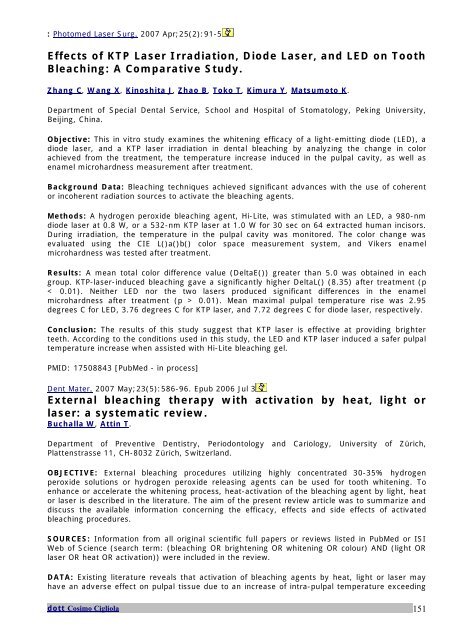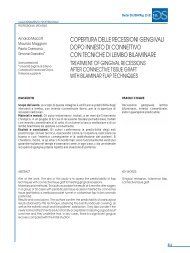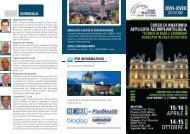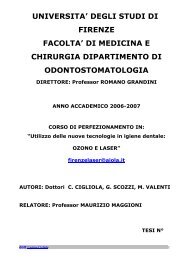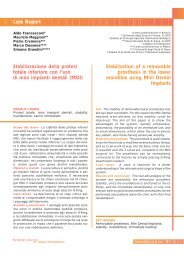LASER E SBIANCAMENTO - Maurizio Maggioni
LASER E SBIANCAMENTO - Maurizio Maggioni
LASER E SBIANCAMENTO - Maurizio Maggioni
Create successful ePaper yourself
Turn your PDF publications into a flip-book with our unique Google optimized e-Paper software.
: Photomed Laser Surg. 2007 Apr;25(2):91-5<br />
Effects of KTP Laser Irradiation, Diode Laser, and LED on Tooth<br />
Bleaching: A Comparative Study.<br />
Zhang C, Wang X, Kinoshita J, Zhao B, Toko T, Kimura Y, Matsumoto K.<br />
Department of Special Dental Service, School and Hospital of Stomatology, Peking University,<br />
Beijing, China.<br />
Objective: This in vitro study examines the whitening efficacy of a light-emitting diode (LED), a<br />
diode laser, and a KTP laser irradiation in dental bleaching by analyzing the change in color<br />
achieved from the treatment, the temperature increase induced in the pulpal cavity, as well as<br />
enamel microhardness measurement after treatment.<br />
Background Data: Bleaching techniques achieved significant advances with the use of coherent<br />
or incoherent radiation sources to activate the bleaching agents.<br />
Methods: A hydrogen peroxide bleaching agent, Hi-Lite, was stimulated with an LED, a 980-nm<br />
diode laser at 0.8 W, or a 532-nm KTP laser at 1.0 W for 30 sec on 64 extracted human incisors.<br />
During irradiation, the temperature in the pulpal cavity was monitored. The color change was<br />
evaluated using the CIE L()a()b() color space measurement system, and Vikers enamel<br />
microhardness was tested after treatment.<br />
Results: A mean total color difference value (DeltaE()) greater than 5.0 was obtained in each<br />
group. KTP-laser-induced bleaching gave a significantly higher DeltaL() (8.35) after treatment (p<br />
< 0.01). Neither LED nor the two lasers produced significant differences in the enamel<br />
microhardness after treatment (p > 0.01). Mean maximal pulpal temperature rise was 2.95<br />
degrees C for LED, 3.76 degrees C for KTP laser, and 7.72 degrees C for diode laser, respectively.<br />
Conclusion: The results of this study suggest that KTP laser is effective at providing brighter<br />
teeth. According to the conditions used in this study, the LED and KTP laser induced a safer pulpal<br />
temperature increase when assisted with Hi-Lite bleaching gel.<br />
PMID: 17508843 [PubMed - in process]<br />
Dent Mater. 2007 May;23(5):586-96. Epub 2006 Jul 3<br />
External bleaching therapy with activation by heat, light or<br />
laser: a systematic review.<br />
Buchalla W, Attin T.<br />
Department of Preventive Dentistry, Periodontology and Cariology, University of Zürich,<br />
Plattenstrasse 11, CH-8032 Zürich, Switzerland.<br />
OBJECTIVE: External bleaching procedures utilizing highly concentrated 30-35% hydrogen<br />
peroxide solutions or hydrogen peroxide releasing agents can be used for tooth whitening. To<br />
enhance or accelerate the whitening process, heat-activation of the bleaching agent by light, heat<br />
or laser is described in the literature. The aim of the present review article was to summarize and<br />
discuss the available information concerning the efficacy, effects and side effects of activated<br />
bleaching procedures.<br />
SOURCES: Information from all original scientific full papers or reviews listed in PubMed or ISI<br />
Web of Science (search term: (bleaching OR brightening OR whitening OR colour) AND (light OR<br />
laser OR heat OR activation)) were included in the review.<br />
DATA: Existing literature reveals that activation of bleaching agents by heat, light or laser may<br />
have an adverse effect on pulpal tissue due to an increase of intra-pulpal temperature exceeding<br />
dott Cosimo Cigliola 151
the critical value of 5.5 degrees C. Available studies do not allow for a final judgment whether<br />
tooth whitening can either be increased or accelerated by additional activation.<br />
CONCLUSION: Therefore, application of activated bleaching procedures should be critically<br />
assessed considering the physical, physiological and patho-physiological implications.<br />
PMID: 16820199 [PubMed - indexed for MEDLINE]<br />
Br Dent J. 2006 Jun 10;200(11):631-4; discussion 619<br />
Surface and pulp chamber temperature rises during tooth<br />
bleaching using a diode laser: a study in vitro.<br />
Sulieman M, Rees JS, Addy M.<br />
Division of Restorative Dentistry, Department of Oral & Dental Science, University of Bristol Dental<br />
School, Lower Maudlin Street, Bristol, BS1 2LY. m.sulieman@bristol.ac.uk<br />
OBJECTIVE: To measure the surface and pulp chamber temperature increases in vitro on upper<br />
and lower anterior teeth during a tooth whitening procedure using a diode laser.<br />
METHOD: A thermocouple was used to measure the temperature increase on the surface of an<br />
extracted upper central incisor tooth. Pulp chamber temperature readings were made on upper<br />
and lower central incisors, lateral incisors and canines. A diode laser recommended for tooth<br />
bleaching was tested at three different power settings (1W, 2W, 3W). Temperature measurements<br />
were made with and without the bleaching agent present on the labial tooth surface.<br />
RESULTS: The increase in surface temperature readings ranged from 37 degrees C (1W) to 86.3<br />
degrees C (3W) with no bleaching gel present. Pulp chamber temperature increases ranged from<br />
4.3 degrees C (1W) to 16 degrees C (3W). The presence of the bleaching gel reduced temperature<br />
increases seen at the tooth surface and within the pulp.<br />
CONCLUSIONS: The increase in the pulp chamber temperature with the laser used at 1-2W was<br />
below the critical temperature increase of 5.5 degrees C thought to produce irreversible pulpal<br />
damage. However, a power setting of 3W produced a pulp chamber temperature increase above<br />
this threshold (16 degrees C) and caution is advised when using this setting.<br />
PMID: 16767142 [PubMed - indexed for MEDLINE]<br />
Influence of fluorescence-controlled Er:YAG laser radiation,<br />
the Vector system and hand instruments on periodontally<br />
diseased root surfaces in vivo.<br />
Schwarz F, Bieling K, Venghaus S, Sculean A, Jepsen S, Becker J.<br />
Department of Oral Surgery, Heinrich Heine University, Dusseldorf, Germany. info@frankschwarz.de<br />
2004<br />
OBJECTIVES: The aim of the present study was to evaluate the effects of fluorescence-controlled<br />
Er:YAG laser radiation, an ultrasonic device or hand instruments on periodontally diseased root<br />
surfaces in vivo.<br />
MATERIAL ANDMETHODS: Seventy-two single-rooted teeth (n=12 patients) were randomly<br />
treated in vivo by a single course of subgingival instrumentation using (1-3) an Er:YAG laser<br />
dott Cosimo Cigliola 152
(ERL1: 100 mJ; ERL2: 120 mJ; ERL3: 140 mJ; 10 Hz), or (4) the Vector ultrasonic system (VUS)<br />
or (5) hand instruments (SRP). Untreated teeth served as control (UC). Areas of residual<br />
subgingival calculus (RSC) and depth of root surface alterations were assessed<br />
histo-/morphometrically.<br />
RESULTS: Highest values of RSC areas (%) were observed in the SRP group (12.5+/-6.9).<br />
ERL(1-3) (7.8+/-5.8, 8.6+/-4.5, 6.2+/-3.9, respectively) revealed significantly lower RSC areas<br />
than SRP. VUS (2.4+/-1.8) exhibited significantly lower RSC areas than SRP and ERL(1, 2).<br />
Specimens treated with SRP revealed conspicuous root surface damage, while specimens treated<br />
with ERL(1-3) and VUS exhibited a homogeneous and smooth appearance.<br />
CONCLUSION: Within the limits of the present study, it may be concluded that ERL and VUS<br />
enabled (i) a more effective removal of subgingival calculus and (ii) a predictable root surface<br />
preservation in comparison with SRP.<br />
---------------------------------------------------------------------------------------<br />
Treatment of periimplantitis with laser or ultrasound. A review<br />
of the literature [Article in German]<br />
Schwarz F, Bieling K, Sculean A, Herten M, Becker J.<br />
Poliklinik fur Zahnarztliche Chirurgie und Aufnahme, Westdeutsche Kieferklinik, Heinrich-Heine-<br />
Universitat, Dusseldorf, Deutschland. info@frank-schwarz.de<br />
In addition to conventional treatment modalities (mechanical and chemical), the use of different<br />
lasers has been increasingly proposed for the treatment of peri-implantitis. Results from both<br />
controlled clinical and basic studies have pointed to the high potential of an Er:YAG-laser. Its<br />
excellent ability to effectively ablate dental calculus without producing major thermal side-effects<br />
to adjacent tissue has been demonstrated in numerous studies. Recently, a new ultrasonic device<br />
has been used for the treatment of periodontal and peri-implantitis infections. Preliminary clinical<br />
data indicate that treatment with both treatment procedures may positively influence peri-implant<br />
healing. The aim of the present review paper is to evaluate, based on the available evidence, the<br />
use of an Er:YAG-laser and a newly introduced ultrasonic device for treatment of peri-implantitis<br />
in comparison to a conventional treatment approach.<br />
------------------------------------------------------------------------------------------<br />
Periodontal treatment with an Er:YAG laser or scaling and root<br />
planing. A 2-year follow-up split-mouth study.<br />
Schwarz F, Sculean A, Berakdar M, Georg T, Reich E, Becker J.<br />
Department of Oral Surgery, Heinrich Helne University, Westdeutsche Kieferklinik, Dusseldorf,<br />
Germany. info@frank-schwarz.de 2003<br />
BACKGROUND: Non-surgical periodontal treatment with an Er:YAG laser has been shown to<br />
result in significant clinical attachment level gain; however, clinical results have not been<br />
established on a long-term basis following Er:YAG laser treatment. Therefore, the aim of the<br />
present study was to present the 2-year results following non-surgical periodontal treatment with<br />
an Er:YAG laser or scaling and root planing.<br />
METHODS: Twenty patients with moderate to advanced periodontal destruction were treated<br />
under local anesthesia, and the quadrants were randomly allocated in a split-mouth design to<br />
either 1) Er:YAG laser (ERL) using an energy level of 160 mJ/pulse and 10 Hz, or 2) scaling and<br />
root planing (SRP) using hand instruments. The following clinical parameters were evaluated at<br />
baseline and at 1 and 2 years after treatment: plaque index (PI), gingival index (GI), bleeding on<br />
probing (BOP), probing depth (PD), gingival recession (GR), and clinical attachment level (CAL).<br />
Subgingival plaque samples were taken at each appointment and analyzed using dark-field<br />
microscopy for the presence of cocci, non-motile rods, motile rods, and spirochetes. The primary<br />
outcome variable was CAL. No statistically significant differences between the groups were found<br />
at baseline. Power analysis to determine superiority of ERL treatment showed that the available<br />
sample size would yield 99% power to detect a 1 mm difference.<br />
dott Cosimo Cigliola 153
RESULTS: The sites treated with ERL demonstrated mean CAL change from 6.3 +/- 1.1 mm to<br />
4.5 +/- 0.4 mm (P < 0.001) and to 4.9 +/- 0.4 mm (P < 0.001) at 1 and 2 years, respectively.<br />
No statistically significant differences were found between the CAL mean at 1 and 2 years<br />
postoperatively. The sites treated with SRP showed a mean CAL change from 6.5 +/- 1.0 mm to<br />
5.6 +/- 0.4 mm (P < 0.001) and to 5.8 +/- 0.4 mm (P < 0.001) at 1 and 2 years, respectively.<br />
The CAL change between 1 and 2 years did not present statistically significant differences. Both<br />
groups showed a significant increase of cocci and non-motile rods and a decrease in the amount of<br />
spirochetes. However, at the 1- and 2-year examination, the statistical analysis showed a<br />
significant difference for the CAL (P < 0.001, respectively) between the 2 treatment groups.<br />
CONCLUSION: It was concluded that the CAL gain obtained following non-surgical periodontal<br />
treatment with ERL or SRP can be maintained over a 2-year period.<br />
Clinical evaluation of an Er:YAG laser for nonsurgical<br />
treatment of peri-implantitis: a pilot study.<br />
Schwarz F, Sculean A, Rothamel D, Schwenzer K, Georg T, Becker J.<br />
Department of Oral Surgery, Heinrich Heine University, Westdeutsche Kieferklinik, D-40225<br />
Dusseldorf, Germany. info@frank-schwarz.de 2005<br />
The aim of this controlled, parallel design clinical study was to compare the effectiveness of an<br />
Er:YAG laser (ERL) to that of mechanical debridement using plastic curettes and antiseptic therapy<br />
for nonsurgical treatment of peri-implantitis. Twenty patients with moderate to advanced periimplantitis<br />
lesions were randomly treated with either (1) an ERL using a cone-shaped glass fiber<br />
tip at an energy setting of 100 mJ/pulse and 10 pps (ERL), or (2) mechanical debridement using<br />
plastic curettes and antiseptic therapy with chlorhexidine digluconate (0.2%) (C). The following<br />
clinical parameters were measured at baseline, 3 and 6 months after treatment by one blinded<br />
and calibrated examiner: Plaque index (PI), bleeding on probing (BOP), probing depth (PD),<br />
gingival recession (GR) and clinical attachment level (CAL). At the baseline examination, there<br />
were no statistically significant differences in any of the investigated parameters. Mean value of<br />
BOP decreased in the ERL group from 83% at baseline to 31% after 6 months (P < 0.001) and in<br />
the C group from 80% at baseline to 58% after 6 months (P < 0.001). The difference between the<br />
two groups was statistically significant (P < 0.001, respectively). The sites treated with ERL<br />
demonstrated a mean CAL change from 5.8 +/- 1 mm at baseline to 5.1 +/- 1.1 mm (P < 0.01)<br />
after 6 months. The C sites demonstrated a mean CAL change from 6.2 +/- 1.5 mm at baseline to<br />
5.6 +/- 1.6 mm (P < 0.001) after 6 months. After 6 months, the difference between the two<br />
groups was statistically not significant (P > 0.05). Within the limits of the present study, it was<br />
concluded that (i) at 6 months following treatment both therapies led to significant improvements<br />
of the investigated clinical parameters, and (ii) ERL resulted in a statistically significant higher<br />
reduction of BOP than C.<br />
------------------------------------------------------------------------------------------<br />
frank schwarz<br />
Influence of an erbium, chromium-doped yttrium, scandium,<br />
gallium, and garnet (Er,Cr:YSGG) laser on the reestablishment<br />
of the biocompatibility of contaminated titanium implant<br />
surfaces.<br />
Schwarz F, Nuesry E, Bieling K, Herten M, Becker J.<br />
Department of Oral Surgery, Heinrich Heine University, Dusseldorf, Germany. info@frankschwarz.de<br />
BACKGROUND: The aim of the present study was to evaluate the influence of an erbium,<br />
chromium-doped yttrium, scandium, gallium, and garnet (Er,Cr:YSGG laser [ERCL]) on 1) the<br />
dott Cosimo Cigliola 154
surface structure and biocompatibility of titanium implants and 2) the removal of plaque biofilms<br />
and reestablishment of the biocompatibility of contaminated titanium surfaces.<br />
METHODS: Intraoral splints were used to collect an in vivo supragingival biofilm on sand-blasted<br />
and acid-etched titanium disks for 24 hours. ERCL was used at an energy output of 0.5, 1.0, 1.5,<br />
2.0, and 2.5 W for the irradiation of 1) non-contaminated (20 and 25 Hz) and 2) plaquecontaminated<br />
(25 Hz) titanium disks. Unworn and untreated non-irradiated, sterile titanium disks<br />
served as untreated controls (UC). Specimens were incubated with SaOs-2 osteoblasts for 6 days.<br />
Treatment time, residual plaque biofilm (RPB) areas (%), mitochondrial cell activity (MA) (counts<br />
per second), and cell morphology/surface changes (scanning electron microscopy [SEM]) were<br />
assessed.<br />
RESULTS: 1) ERCL using either 0.5, 1.0, 1.5, 2.0, or 2.5 W at both 20 and 25 Hz resulted in<br />
comparable mean MA values as measured in the UC group. A monolayer of flattened SaOs-2 cells<br />
showing complete cytoplasmatic extensions and lamellopodia was observed in both ERCL and UC<br />
groups. 2) Mean RPB areas decreased significantly with increasing energy settings (53.8 +/- 2.2<br />
at 0.5 W to 9.8 +/- 6.2 at 2.5 W). However, mean MA values were significantly higher in the UC<br />
group.<br />
CONCLUSION: Within the limits of the present study, it was concluded that even though ERCL<br />
exhibited a high efficiency to remove plaque biofilms in an energy-dependent manner, it failed to<br />
reestablish the biocompatibility of contaminated titanium surfaces<br />
---------------------------------------------------------------------------------------<br />
J Clin Periodontol. 2002 Mar;29(3):211-5.<br />
Desensitizing effects of an Er:YAG laser on hypersensitive<br />
dentine.<br />
Schwarz F, Arweiler N, Georg T, Reich E.<br />
Department of Oral and Maxillofacial Surgery, Ludwig Maximilians University, Munich, Germany.<br />
AIM: The aim of the present study was to evaluate and compare the desensitizing effects of an<br />
Er:YAG laser (KEY II(R), KaVo, Germany) and Dentin Protector (Vivadent, Germany) on cervically<br />
exposed hypersensitive dentine.<br />
METHOD: A group of 30 patients showing a total of 104 contralateral pairs of hypersensitive and<br />
caries-free teeth was selected and randomly allocated in a split-mouth design to either (1) Er:YAG<br />
laser (80 mJ/pulse, 3 Hz), or (2) the application of Dentin Protector (polyurethane-isocyanate<br />
22.5%; methylenechloride 77.5%) whereat one pair served as an untreated control in each<br />
patient. The degree of sensitivity to a thermal stimulus was determined qualitatively with an<br />
evaporative stimulus defined as a 3-s air blast at a distance of 2 mm from each site to be tested.<br />
A qualitative registration of the degree of discomfort was determined according to an arbitrary<br />
pain scale in 4 degrees. Recordings were assessed before treatment, immediately after, 1 week, 2<br />
and 6 months after treatment by 1 blinded examiner.<br />
RESULTS: Both treatment forms resulted in significant improvements of discomfort immediately<br />
after and 1 week post treatment. After 2 months, the discomfort in the Dentin Protector(R) group<br />
increased up to 65% of the baseline score and even up to 90% after 6 months, whereas the effect<br />
of the laser remained at the same level that was achieved immediately after treatment. The<br />
differences immediately after, 1 week, 2 and 6 months post treatment between both groups were<br />
statistically high significant (p< or =0.001; respectively). Compared to the untreated control<br />
group, both treatment forms resulted in a significant reduction of discomfort at each follow-up<br />
examination.<br />
CONCLUSION: It was concluded that desensitizing of hypersensitive dentine with an Er:YAG laser<br />
is effective and the maintenance of the positive result was more prolonged than with Dentin<br />
Protector.<br />
dott Cosimo Cigliola 155


